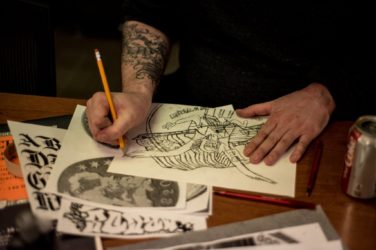 [dropcap]E[/dropcap]arly in the 20th century, a gifted generation of Midwestern artists captured the world’s attention with their depictions of life on local farms. Early in the 21st century, a gifted generation of Iowa artists acknowledges the examples set by their predecessors yet eagerly transverses the globe, their work resonating with meanings from many countries. Here are five to know.
[dropcap]E[/dropcap]arly in the 20th century, a gifted generation of Midwestern artists captured the world’s attention with their depictions of life on local farms. Early in the 21st century, a gifted generation of Iowa artists acknowledges the examples set by their predecessors yet eagerly transverses the globe, their work resonating with meanings from many countries. Here are five to know.
Amy Worthen
Amy Worthen spends half her year in Venice and half in Des Moines. It speaks volumes about her organizational and planning skills that she manages to do this, because she’s curator of prints and drawings at the Des Moines Art Center. And for many years now, Worthen herself has also been a much-exhibited printmaker.
Her prints are based on drawings, faithfully executed daily. She brings a connoisseur’s eye and a lyrical hand to Venetian architecture, whether storied structures like the interior of the Temple of Thieves, or more mundane ones like the city’s covered street passages (“sottoporteghi”). Her most recent project blends aspects of her two homes. A commissioned print of Iowa State University’s old Marston Hall was sketched in Ames, engraved in
Des Moines and printed in Venice.
The robust beaux arts facade captured in Worthen’s image elicited puzzlement from her Italian circle, who asked, “What villa is that?” Worthen laughs with pleasure at the recollection. “This piece, ‘Apotheosis at Marston Hall,’ is emblematic of how I work now—moving between Iowa and Italy.”
 Charles Barth
Charles Barth
Charles Barth taught art at Mount Mercy University in Cedar Rapids for three decades. Now, every year, he spends just four good-weather months there—March, April, September and October. The other eight months, he lives in Oaxaca, Mexico, where the climate is pleasant year-round. But for Barth, breezy afternoons aren’t by any stretch the real enticement.
Spellbound by Mexico’s indigenous culture, crafts and colors, Barth set up a house and studio in Oaxaca in 1997. Ever since, his vibrant, teeming prints reveal an artist in love. Like a many-hued merry-go-round, populated with tattooed wrestling stars, fiery cultural icons including Diego Rivera and Frida Kahlo, Day-of-the-Dead skeletons, monkeys and other irreverent creatures, Barth’s pieces glow with a mesmerizing south-of-the-border vitality. However, the stars and planets that often twinkle above his merry fiestas are affectionate tributes to rural Iowa’s dazzling nighttime displays.
Barth’s art attracts Mexicans as well as Americans, a fact that pleases him. “Mexicans can even more
easily identify the figures and activities I’m depicting,” he says. And, cautious tourists, take note: Barth decrees Oaxaca perfectly safe for travel these days.

 Michael and Charlotte Cain
Michael and Charlotte Cain
Michael and Charlotte Cain are both recognized artists: He sculpts, she paints. East Coasters who now live in Fairfield, their interest in Transcendental Meditation has kept them shuttling back and forth from India since 1970. Their longest sojourn lasted 17 months; during that trip, as always, they studied and worked with skilled craftspeople.
“My romance with India,” Michael recalls, “began in college with the writings of a philosopher of Indian art named Ananda Coomaraswamy.” Retired from Maharishi University of Management, where he founded the art department, Michael is preparing for a retrospective exhibition at Fairfield’s ICON gallery in 2013. The show will include small cast-metal sculptures he describes as joining “American minimalism with cosmological ideas inspired by tantric art.”
Charlotte, too, is planning a retrospective at ICON, following Michael’s. Charlotte paints delicate, decorative abstractions she says are “attempts at expressing my experience of silence. I do this work for myself, because it makes me feel good.”
She often summons up advice given by her teacher, Bannu Sharma, one of India’s most celebrated miniaturists. “He said, ‘The most important thing is the brush—dancing with the brush.’ ”
 Ignatius Widiapradja
Ignatius Widiapradja
An artist and academic, Ignatius Widiapradja isn’t the person you might single out to be a flag-waving Iowan with a raft of solidly Midwestern collectors and admirers. Born in Indonesia, he came to the United States in 1979 to attend college in El Paso. (Discrimination against Indonesians of Chinese descent limited his chances of getting into art school back home. A family friend living in Texas—the only person he knew in America—encouraged his move.)
Now a U.S. citizen, Widiapradja is an associate professor of art at Drake University and also consults with an international Indonesian jewelry corporation. Although he readily calls Des Moines home, he finds time to make art in and wander extensively through Asia, including Tibet, China, Cambodia, Laos and Nepal.
His most recent works, exhibited at Moberg Gallery in Des Moines, are huge digital prints—complex landscapes teeming with growth and decay, populated with mythical figures and enveloped in swirling mists. Once pulled into these intricate pieces, you discover fantastical mixes of far-flung ancient monuments and exotic vistas—a stone face from the Bayon temple in the Angkor region of Cambodia alongside the Taktsang Palphug Monastery in Bhutan, with Nepal’s Annapurna mountain range rising as a majestic backdrop. Widiapradja refers to these impossible juxtapositions as dreamscapes. “They’re how I see the world,” he says. “Things appear, things dissolve, endlessly. Nothing is lost.”
Despite his roots abroad, Widiapradja values Drake as the place that, more than two decades ago, formed and nurtured his mature style. He says the school’s creative, intellectual atmosphere was especially embodied by the late Jules Kirschenbaum. This artist’s detailed, well-crafted paintings stood bravely outside the broadly brushed, graffiti-splashed 1980s art world. Kirschenbaum’s independence, his resolve to find his own path, continue to embolden Widiapradja’s choices.
Written by Loulou Kane



